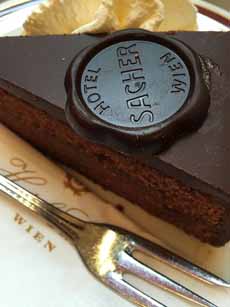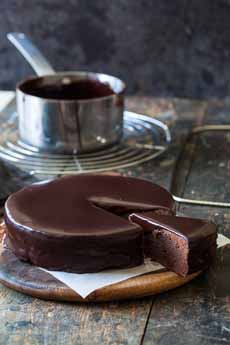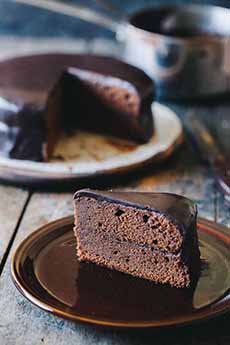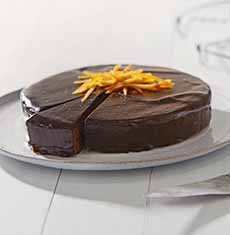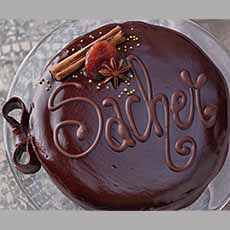Sacher Torte Recipe & History For National Sacher Torte Day
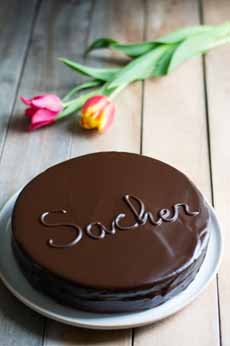 [1] Sacher Torte, a classic with the word “Sacher” inscribed on the top. Here’s a recipe from Chic, Chic, Chocolate.
|
December 5th is National Sacher Torte Day. In German it’s spelled Sachertorte, in English it becomes Sacher Torte. Once one of the most sought-after chocolate cakes, two short layers (torte-style), separated by a thin layer of apricot jam and covered with a thick, glossy ganache. The recipe is below, but first: The torte was the creation of a young pastry apprentice in 1832 Vienna. Franz Sacher (1816–1907) was a 16-year-old apprentice at the court of the Austrian Prince Klemens von Metternich. Even if he had been only a prince, there would have been incessant fine dinners at which dazzling food was expected. But von Metternich was also the Austrian State Chancellor. Diplomats, heads of state, and other dignitaries were invited to his official table. Franz must have been a star in the making because one day the teenager was asked to create an especially impressive dessert for a reception. He created what was to become a world-famous chocolate cake: a two-layer torte (see below) filled with apricot jam. The guests loved it, and it became known as the Sacher Torte (Sachertorte in German, pronounced ZAH-chur (guttural ch) TORT). Eduard Sacher (1843–1892) was Franz’s son, a restaurateur and purveyor to the court. He made his father’s recipe at the Hotel Sacher. Café Demel in Vienna was once the bakery favored by the House of Habsburg, the Viennese royal family. They also made a Sachertorte. In the early part of the 20th century, Café Sacher and Café Demel engaged in a lawsuit over who could claim to have made the original Sachertorte. The recipe of the Hotel Sacher’s version of the cake (photos #2 and #3) is a “closely-guarded secret”—not of the cake itself, but of the luscious, bittersweet chocolate icing. According to widely available information, the icing consists of three special types of chocolate, which are produced exclusively by different manufacturers (no one producer has the combination). The difference between glaze and icing is procedural: Icing more commonly refers to the process of covering the cake. Glazer refers to the technique of pouring on the topping, instead of using a spatula (photo #3). Given the “secrecy,” bakers created many copycats. Some add a third layer (photo #4), and some substitute raspberry jam for the apricot. Beyond writing “Sacher Torte” in icing (photo #7), some bakers use fanciful decorations, like dried apricots circling the rim of the cake, a riff on the apricot jam in the center. You can see other garnishes in photos #8 and #9. When we saw our first Sacher Torte many years ago at the Eclair Bakery in New York City, our child’s eyes were drawn to the glossy chocolate icing and the word Sacher, written in script across the top (photos #1 and #7). It became our favorite cake for more decades still—until flourless chocolate cake made its debut. We still love Sacher Torte, but the bakeries that specialized in classic European cakes have disappeared as their pastry chefs have retired. One of these days we’ll have to get to the Hotel Sacher and to Demel’s pastry shop, both in Vienna. It’s still cheaper to order a Sacher Torte from the hotel: 52,50 €. The shipping to New York is almost as much: 37,99 €. Get yours at Shop.HotelSacher.com. Or, bake one with the recipe below from King Arthur Flour. Ingredients For The Cake (9″) 1. PREHEAT the oven to 350°F. Spray one 9″ x 2″ round cake pan with cooking spray and line with parchment. Spray the parchment lightly as well. If your pan isn’t at least 2″ deep, use two pans instead of one. 2. MELT the chocolate slowly over low heat or in the microwave, stirring well. 3. LIGHTLY BEAT the 8 egg yolks in a small bowl. Add the melted chocolate, melted butter, and vanilla. Blend until smooth and satiny, with no lumps or unincorporated yolks. 4. BEAT the 8 egg whites with a pinch of salt in the bowl of a stand mixer, until they begin to foam. Slowly add the sugar, then beat on high speed until the whites hold a stiff peak but are still glossy. Using a wide rubber spatula, mix about 1/3 of the egg whites into the chocolate/yolk mixture to lighten it. 5. POUR the lightened chocolate mixture over the rest of the whites in the bowl. Fold gently, using about 20 to 30 strokes. Sprinkle the cake flour over the chocolate batter and continue to fold gently until there are no traces of egg white remaining. 6. POUR the batter into the pan(s). Bake until the cake is puffed and dry looking on top, and a cake tester inserted into the center comes out clean: 40 to 45 minutes for a single pan, 20 to 25 minutes for two pans. Remove from the oven and cool in the pan(s) for 10 minutes before turning out onto a wire rack to cool completely. Be sure to peel off the parchment circle while the cake is still warm. While the cake is cooling…. 7. STRAIN the apricot jam through a fine sieve to remove any bits of fruit and make a smooth filling. 8. FILLING the cake: If you used one cake pan, you will need to split the layer before filling. Use a long, sharp serrated knife to split the cake into two even layers. If you used two pans, simply spread the apricot jam between the layers, leaving 1/2 inch around the border so that the jam does not squeeze out over the sides of the cake. 9. MAKE the chocolate glaze: Place the filled cake on a wire rack over a parchment-lined baking sheet. Place the chocolate, water, and sugar in a medium-sized saucepan over medium-low heat. Cook, stirring frequently until the glaze is smooth, shiny and slightly thickened, about 4 to 5 minutes. As soon as the glaze is smooth… 10. IMMEDIATELY pour it over the cake. The excess glaze will drip off of the cake onto the parchment paper. You can scoop up the excess glaze to cover any bare spots on the cake. Use a flexible spatula to help spread the glaze on the top and sides of the cake, but do not overwork the glaze or it will not remain smooth and sleek. 11. ALLOW the glaze to set up at room temperature for a few hours before serving. This cake is best served the day it’s made. Store any leftovers at room temperature for 1 day. What’s the difference between a cake and a torte? It depends on whom you ask. Essentially, torte is the German word for cake. As opposed to a pound cake or a a loaf cake, a yeast cake or other casual style, a torte denotes a rich, dense cake made with many eggs and little or no flour. Instead, it uses ground nuts (and sometimes breadcrumbs) for texture. Tortes are also shorter and wider—often no more than 2-1/2 inches high, and 10 to 12 inches in diameter. Some “flourless chocolate cakes” are made with ground nuts like tortes. So is a flourless chocolate cake a cake or a torte? Based on the number of eggs, the lack of flour, the low height, and the broad width, the answer is torte. |
|
|
|
||
